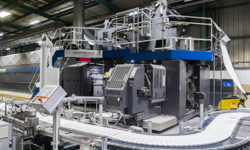
It has been another tough year for paper and print, but there aren’t many sectors who have been immune from the same challenges, and like them, we simply adapt and innovate as best we can in order to continue.
In the meantime, it’s important that we don’t lose sight of the importance of physical publications, not only in terms of their content but also with regard to their sustainability attributes. So, whatever paper you print on, and wherever you print, here are some facts that should always be embraced:
- Paper is made from a natural and renewable resource – trees!
- Paper fibre can be recycled up to eight times.
- Paper is one of the most often recycled materials, accounting for over half (in terms of weight) of all materials collected for recycling.
- Almost three quarters of all paper consumption is recycled in the UK and in the EU each year.
- Paper comes from commercial forestry – not ancient woodlands or tropical rain forests.
- The overwhelming majority of commercial forestry throughout the planet is certified to a forest management scheme to ensure ecological, environmental and social welfare is sustained. FSC and PEFC are the most well-known forest management schemes with recognised logos that can be printed on publications, leaflets etc.
- The FSC and PEFC schemes are based on the chain of custody principle, enabling paper products to be traced back to their tree origins – ie. species as well as country of harvest.
- Paper fibre is generally obtained from the top quarter of a tree. The main part of a harvested tree is used for construction and furniture manufacture, and paper mills are traditionally part of bigger groups associated with timber production.
- UK timber regulations prevent any illegally logged timber or timber derived products – including paper – to be imported into the UK. The EU timber regulations applies the same legislation throughout Europe, as does the Lacey Act in North America.
- The paper industry is among the most regulated in the world, to the point that most mills are certified, as a minimum, to the international standards for health and safety, quality, environmental and energy management.
- Paper manufacture can be measured in terms of its carbon footprint, therefore making it a valid commodity for carbon offsetting. This is a growing area in paper and print with schemes such as Carbon Balanced Paper helping printers and publishers enhance their sustainability profiles.
- Finally. Once paper has been recycled more than eight times, and its fibres become too short for paper production, it has a use as a soil improvement agent. So, what comes from the ground eventually goes back into the ground – truly circular.

About us
Denmaur has been one of the established names in the print and publishing sectors since 1983. Today, Denmaur Paper Media has become one of the leading specialist paper suppliers in the UK, offering a comprehensive range of innovative and sustainable products to suit traditional and modern print processes.
Email: ddoogan@denmaur.com
LinkedIn: www.linkedin.com/in/danny-doogan-b795195a
Twitter: @ENVIRO_PAPER
This article was first published in the Publishing Partners Guide (PPG) 2023, which is published and distributed by InPublishing. You can register to receive InPublishing magazine here.










